https://www.youtube.com/watch?v=Jed0xGPH_HM
One Killer Pontiac - The 1965 Pontiac Catalina 421 3-2bbl V8 (356hp) Was a Gentleman's Hotrod
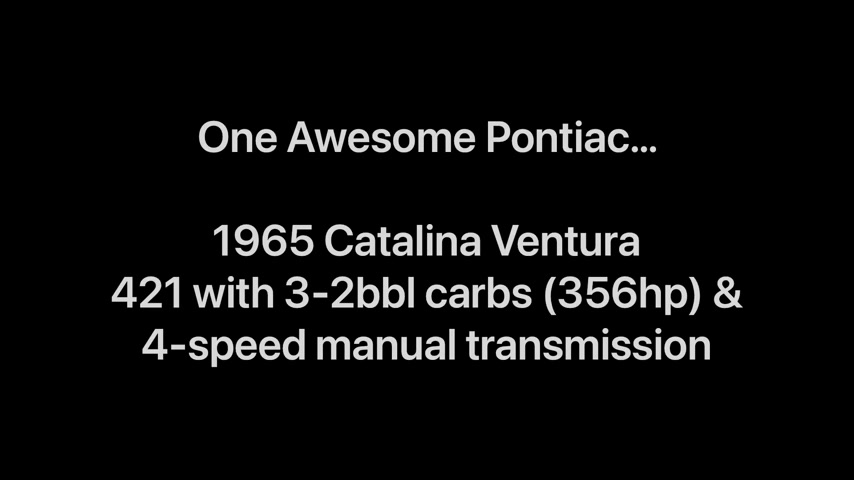
When it comes to the pinnacle of Pontiac Motor Division , there are a few years that are better than the 1965 model year for full size Pontiacs , the cars were absolutely beautiful , had wonderful engines and transmissions looked great and drove and rode like nothing else before or since .
And this particular vehicle is a very special full size Pontiac from 1965 .
It's a 1965 Pontiac Catalina Ventura trim , two door sports coupe and it's equipped with a very rare 421 cubic inch , 356 horsepower 32 barrel engine and a four speed manual transmission with her shifter .
Let's walk around the vehicle a little bit and discuss more in detail about some of its finer elements .
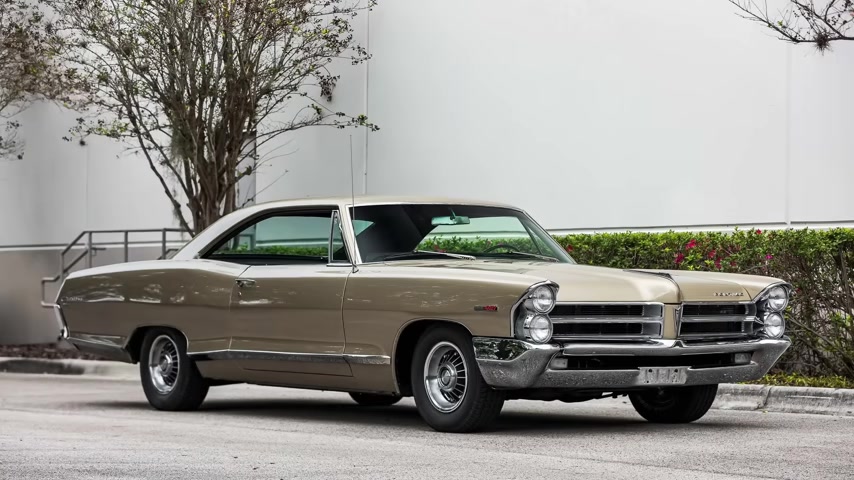
Now , the Catalina was Pontiac's entry level full size vehicle for the 1965 model year and it was the short wheel base .
Pontiac .
It rode atop 121 inch wheel base and was about 215 inches in overall length .
One up from the Catalina was the star chief , which was a bit more of an exclusive vehicle and then one up from the Star Chief was the Bonneville , the star chief and the Bonneville were both on 100 and 24 inch wheel bases and we were about 222 inches in overall length .
There was also Pontiac's sporty full size car which was the Grand Prix and that road atop the same wheel base as the Catalina that you see here .
Now , this Catalina , as I mentioned is a very special vehicle .
This is a Catalina sports coup , which you can see is a hard top , it has no B pillar .
In this photo , the front and rear glass is down a particularly attractive vehicle .
This one does not have the optional rear fender skirts that would come standard on the Bonneville models .
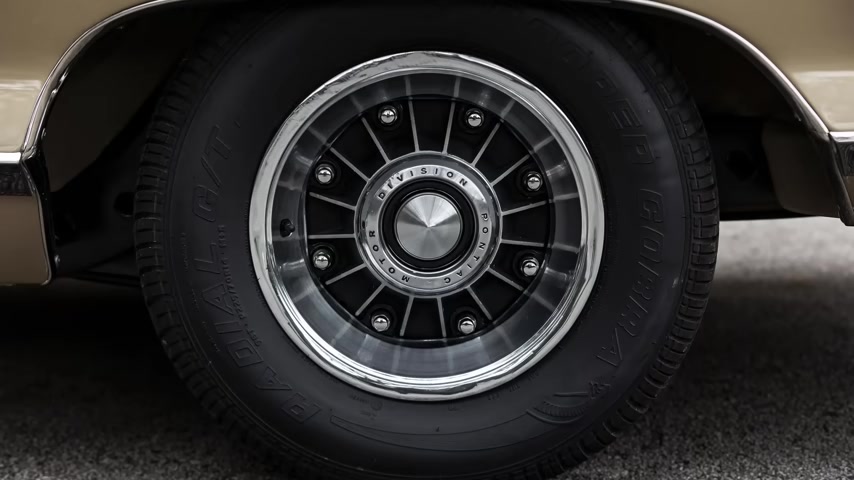
You can see however , that this vehicle does have Pontiac's optional beautiful eight lu wheels .
Let's take a closer look at those now and here's a closer look of that beautiful eight lug brake drum .
The eight lugs were introduced in Pontiacs and were a Pontiac exclusive beginning in the 1960 model year and continued on through the 1968 model year after 1968 disc brakes became much more popular on vehicles .
And so the eight lug design was just outmoded and this eight lug design was outmoded because it only worked on drum brakes and they worked quite effectively .
It was effectively an 11 inch aluminum drum , aluminum was used to dissipate heat more quickly that was attached to a 14 by six steel rim .
It was pandered off of a number of pan hard wheels from the mid 19 fifties .
But Pontiac made the design their own and unique .
And then of course , others tried to copy this design .
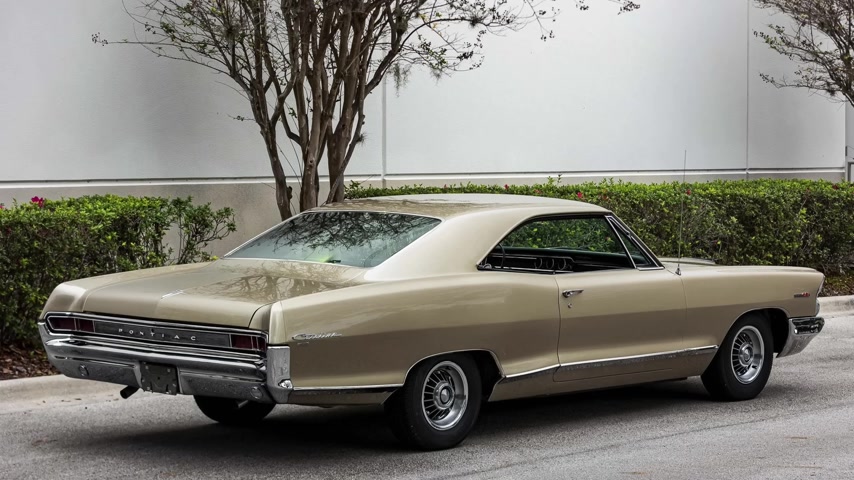
One particular wheel cover design for mercury in the mid to late 19 sixties , as you can see here emulates the Pontiac eight lugs , although there are no lugs or pseudo lugs on the wheel cover , but it is clearly close and designed to these Pontiac eight lugs shown here .
And now let's turn to the rear three quarter view of this vehicle .
I think it's one of the handsomest angles of this car .
The roof line is just gorgeous on these Pontiac full size coops .
But the other thing that this rear three quarter view shows off is the so called Coke bottle design of this vehicle and that denotes this kick up in the belt line as you can see right at the sea pillar and on the Pontiac , it's also symmetrical .
You have that belt line kicking up and you have the lower skeg line kind of diving down at the same time .
And if you were to look at this vehicle in plan view or form a bird's eye view , you notice that the car swells at that point as well similar to a Coke bottle .
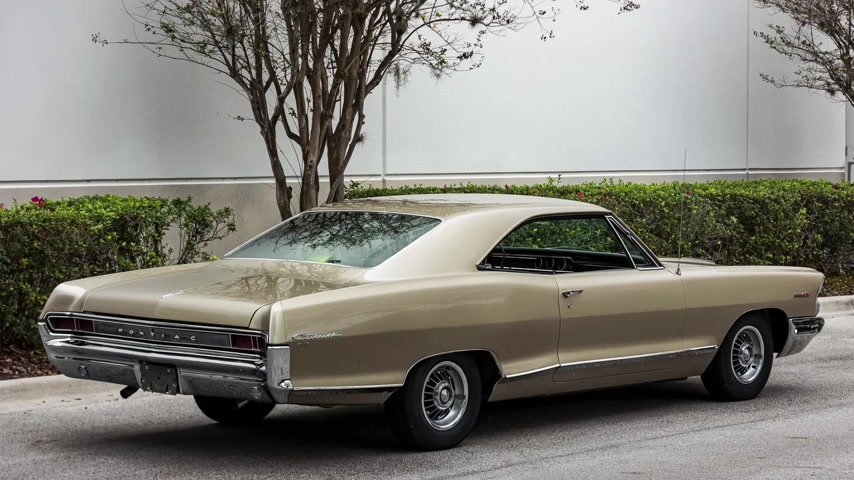
So when you hear someone describe a design as having a Coke bottle like shape , that really means that the car swells out around the rear wheels and then tapers in front and behind that .
And then also has this kick up if you will around that wheel as well in the belt line , let's turn out to the inside of this Pontiac Catalina .
And again , I mentioned that this was a Pontiac Catalina Ventura , which was about 100 plus dollar option on the Catalina vehicles .
And it got you nicer seats and nicer door panels , just a bit nicer interior .
Overall , you could pay a little bit more for a little bit more glitz and glam , but didn't have to step up to the Star Chief or Bonneville .
And you can see it's an overall handsome design .
There's no lights in the sea pillars on the Catalina , there is an overhead dome light and you can also see the shifter on the floor here .
This is a particularly unique vehicle because there's no center console .
The floor shifter is just there and kind of in a cut out in the floor .
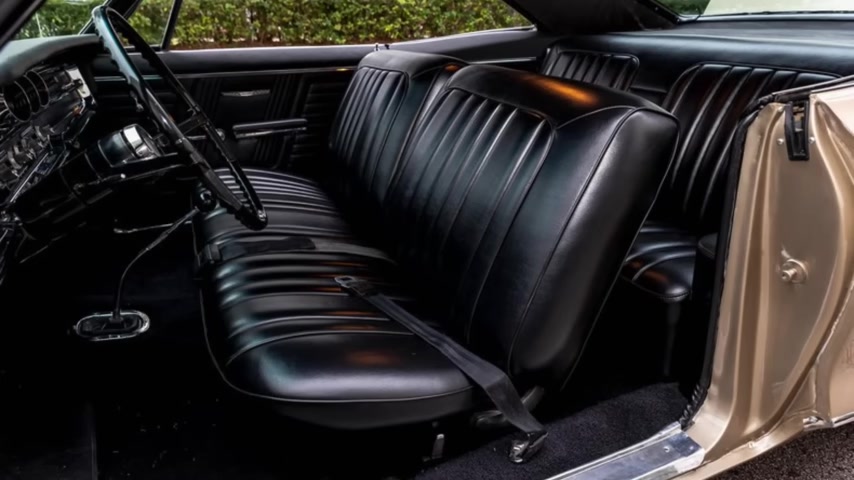
Whereas quite a few times when the manual transmission was optioned , the buyer would opt for a center console , but that's not the case in this vehicle .
And here's one of my favorite features on the interior of this cat .
And that's these three rotated gauges that are canted toward the driver , the fuel gauge , you can see there at the left , the alternator charging indicator in the middle and the clock is at the right , another funny thing about the interior on these cars is that people often think they have two radios because the climate control , which is at the left of this picture appears very similar to the radio in terms of the knobs and overall buttons , but they are very different .
And then in the middle there is the lighter .
So you've got a bunch of these knobs that look very similar .
But in fact , as I mentioned , the left is the climate control and these products have a interesting climate control .
It's not the typical low medium high speed fan .
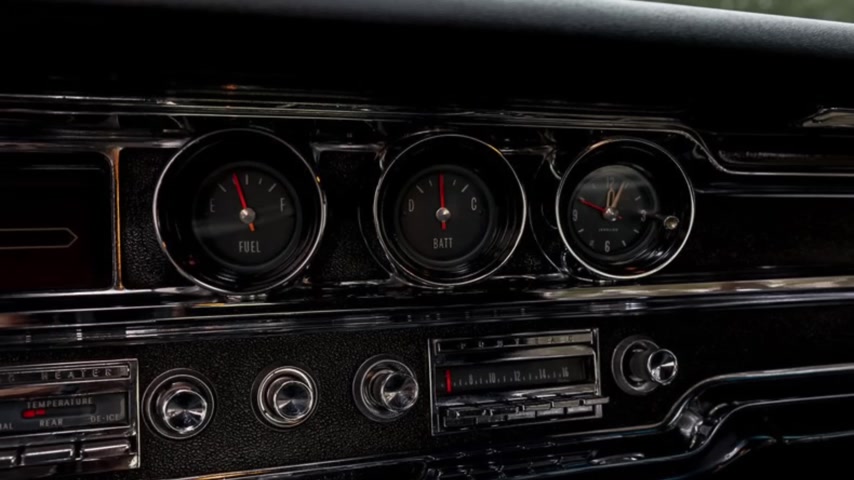
Uh They actually are somewhat automatic in terms of their fan speed .
If you rotate the fan knob and turn the fan on and then rotate the heater control further to more heat , the fan speed actually kicks up and increases as you turn the heater toward a more hot setting .
Something that I don't think other G M divisions did .
It works um not too badly and it's kind of innovative .
It's not quite automatic climate control , but it does , as I mentioned , change the fan speed as you change the heat setting .
And if you had an air conditioned equipped car , it would do the same for cooling .
Well , now let's get to the heart of this piece .
This is the 356 horsepower 421 cubic inch optional engine in these Catalina .
So mentioned there were three different 4 20 ones that were available a 338 horsepower four barrel 4 21 .
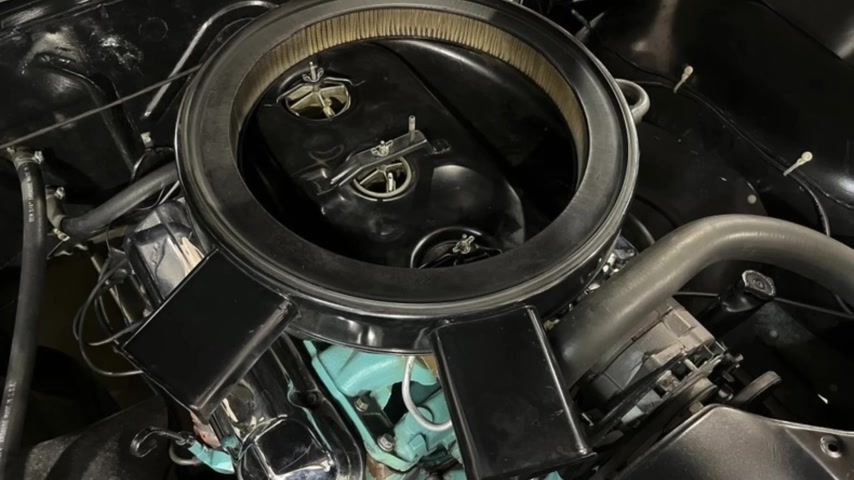
This 356 horsepower , 421 cubic inch V eight .
And then the top dog which was a 376 horsepower high output 421 cubic inch V eight .
And of course in the Catalina lineup , the standard engine was a 3 89 2 barrel V eight premium fuel , two barrel that made 290 gross horsepower .
You get an optional economy engine that was a 3 89 2 barrel but low compression that made 256 horsepower .
And there also were a couple other 3 89 cubic inch engines .
There was a 389 cubic inch four barrel engine that made 325 or 333 horsepower depending on whether or not it was backed by an automatic or manual transmission .
Then there was also a 3932 barrel engine as well that made 338 horsepower .
So boy , oh boy , you could get a lot of engine choices in your Pontiac for 1965 .

But this was one down from the top engine overall and you can see the 32 barrel carburetors that are there and this has the full air cleaner .
If you got the high output 4 21 with 376 horsepower , they were open element individual air cleaners .
And here's a better close up of the 32 barrel set up .
You'll notice that there's a choke heater attached to the middle carburetor and a choke butterfly .
And also that the intake is a bit more stained if you will underneath the middle carburetor than the two outermost carburetors .
That's because the engine operates on only the middle carburetor most of the time .
And then the outer carburetors are only employed when you really step into the throttle on these .
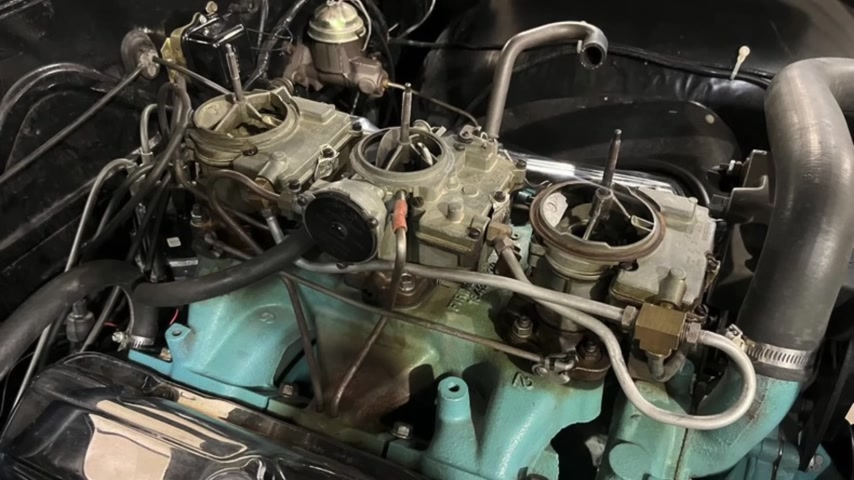
So again , the middle carburetor is the primary carburetor on these 32 barrel Pontiac V eights and other 32 barrel setups also note the chrome valve covers on this particular engine that came standard when you got any of the optional 421 cubic inch V eight S .
And you can see in the background there lurking on the firewall is a single chamber master cylinder .
The single chamber master cylinder would be around until the 1967 model year when they would switch to dual chamber master cylinders .
So better make sure your emergency brake is functioning if you have one of these cars and you haven't changed that set up .
You also note that this is not a power brake car , there is no power brake booster which tends to be fine for drums because they're self energizing .
But disc brake cars without power assist are particularly hard to stop .

And last but not least I wanted to show the code on this Pontiac V eight there all located in the same spot .
You can see the letters W H there right above the water pump and beneath the cylinder head .
If you're looking to decode your Pontiac engine to determine what size engine it is as well as what horsepower look for this two letter code .
And you can then look it up online to see which Pontiac engine you have all Pontiac V eights from 326 cubic inches to 455 cubic inches are the same physical size .
So you're not going to be able to tell what engine you have just by looking at it physically , the 265 cubic inch V eight and 301 cubic inch V eight that Pontiac produced in the 19 eighties and late 19 seventies .
Those engines you can tell are physically smaller .
They have a shorter deck height than these V eights .
But again , any Pontiac V eight , that's 326 to 455 cubic inches is the same physical size .
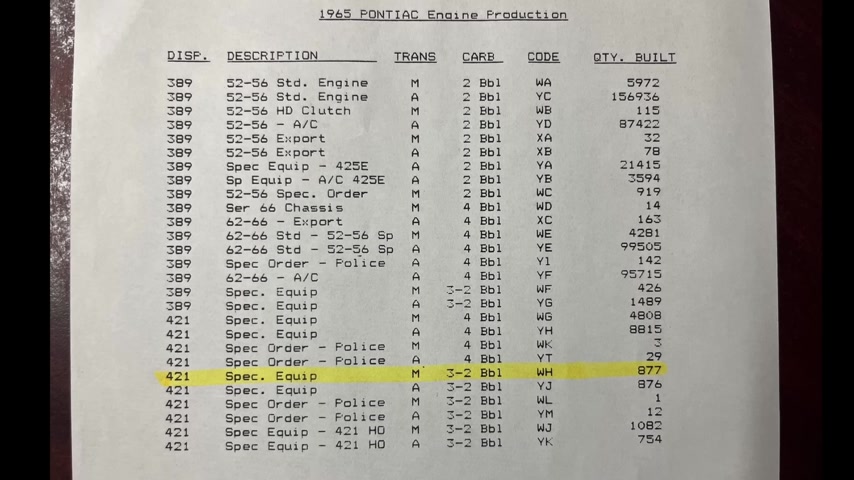
And the best way for you to figure out which engine you have is to decode it with this two letter code that you can see here on the passenger side , that's right beneath the cylinder head and just to show you how rare this particular vehicle is .
Here's a Pontiac engine production chart .
You can see here in terms of the engine that's highlighted , there are only 877 Pontiacs in the entire 1965 model year , they were equipped with this W H code engine which meant that it was the 421 32 barrel 356 horsepower V eight backed by a manual transmission .
You can see in that transmission column that it has an M for manual transmission .
But in general , take a look at the production figures for any 4 21 engine .
And you can see they're very , very low compared to the 389 cubic inch engines and the production listed above them .
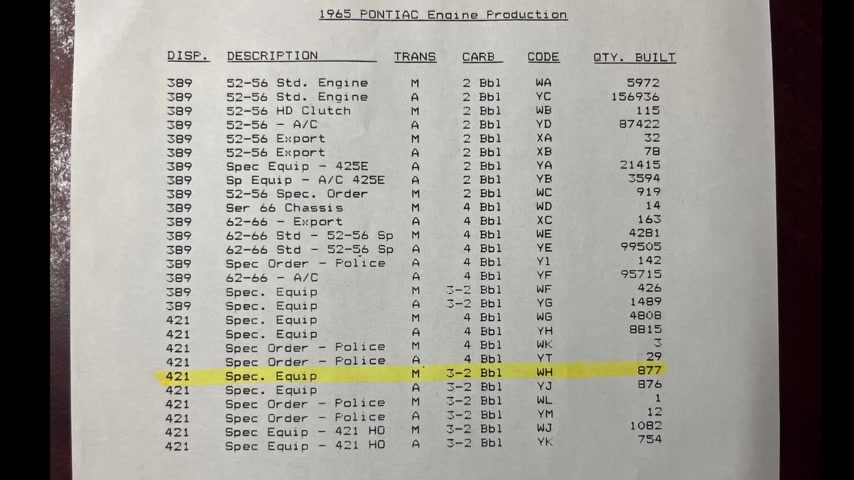
So if you're able to find any Pontiac with any 4 21 V eight , it is definitely a special engine and something to frankly be prized .
I have a 1965 Bonneville with a 4 21 4 barrel and I just can't say enough about how great the vehicle is .
But I will say that Pontiac's 389 cubic inch V eight I think is one of the most impressive engines that General Motors produce even in standard two barrel 290 horsepower form on these Catalino .
Hope you enjoyed this discussion of a particularly special 1965 Catalina Ventura Sport Coup .
If you did be sure to like , comment and subscribe and check out the video thumbnails at bottom , left and right for some suggestions .
For you ?
Are you looking for a way to reach a wider audience and get more views on your videos?
Our innovative video to text transcribing service can help you do just that.
We provide accurate transcriptions of your videos along with visual content that will help you attract new viewers and keep them engaged. Plus, our data analytics and ad campaign tools can help you monetize your content and maximize your revenue.
Let's partner up and take your video content to the next level!
Contact us today to learn more.